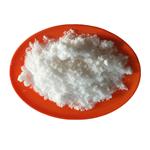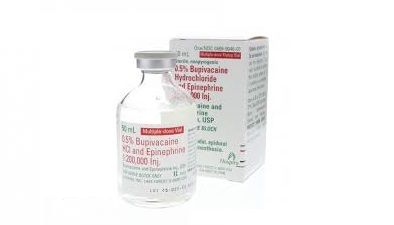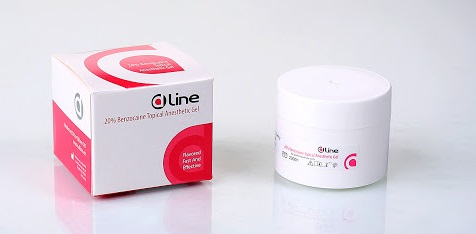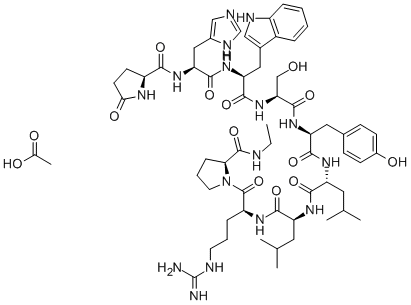Instructions for Leuprolide
Sep 25,2020
Background and overview [1]
Leuprorelin/Leuprolideacetate (LA) is a highly active analogue (LHRH-A, GnRHA) of luteinizing hormone releasing hormone (LHRH, or gonadotropin releasing hormone, GnRH) produced by the hypothalamus. It is a synthetic water-soluble nonapeptide with both ends closed, and its amino acid sequence is 5-oxo-L-prolyl-L-histidyl-L-tryptophan-L-seryl-L-tyrosyl -D-Leucyl-L-Leucyl-L-Arginyl-N-Ethyl-L-Prolinamide Monoacetate (5-oxo-Pro-His-Trp-Ser-Tyr-D- Leu-Leu-Arg-Pro-NH-C2H5), soluble in water, ethanol and propylene glycol, pKa6.9. It can stimulate the pituitary gland to secrete gonadotropins and induce the production of steroids in the reproductive organs. Long-term large-scale use can inhibit the secretion of gonadotropins from the pituitary gland and the production of testicular or ovarian steroids, and can treat or alleviate a variety of sex hormone-dependent diseases such as prostate cancer, endometriosis, uterine fibroids, and precocious puberty.
structure
Pharmacological effects [2]
This product is a nonapeptide synthetic analogue of Luteinizing Hormone Releasing Hormone (LHRH), which can promote the release of follicle-stimulating hormone from the anterior pituitary, thereby reducing the increased testosterone concentration to castrate levels. When the administration is stopped, gonadotropins and androgens can return to normal concentrations.
Applications
1. LA is used to treat prostate cancer
Prostate cancer is the most common tumor in the male genitourinary system. At present, the main treatments for prostate cancer are: radiotherapy, chemotherapy and androgen block therapy. Androgen blocking therapy is the basis for the treatment of prostate cancer. It can be performed by surgical castration or by estrogen, anti-androgen and/or gonadotropin releasing hormone analogues. In the 1970s, Schally synthesized LHRH-A to perform medical castration to reduce testosterone levels in the body, and thus won the Nobel Prize. Schally found that the expression of LHRH receptor and receptor gene is higher in prostate cancer cells, and believes that LHRH-A may have a direct inhibitory effect on cancer.
2. LA is used to treat endometriosis
Endometriosis (endometriosis) is a common benign gynecological disease. Clinical studies have observed that in the current drug treatment process, the lesions temporarily or partially disappear, but they always have metabolic activity and regrowth potential. Therefore, the goal of endometriosis drug treatment should be dedicated to alleviating pain symptoms, improving fertility, and delaying the recurrence of symptoms.
LA is used for endometriosis. The principle is that LA has a strong affinity with the pituitary GnHR receptor and has low sensitivity to peptidase decomposition. Short-term application will stimulate the pituitary to secrete gonadotropin, making follicle hormone (FSH) and corpus luteum LH and estradiol (E2) increase transiently, but long-term continuous use will deplete the GnRH receptors of the pituitary, and the levels of FSH and LH will decrease, resulting in a low estrogen state in the body, causing endometrial disorders Degeneration and atrophy, relieve symptoms.
3. LA is used to treat central precocious puberty
Central precocious puberty is caused by the premature activation of the hypothalamic-pituitary-gonadal axis and the secretion of LHRH pulses. LA reduces the secretion of sex hormones by inhibiting the action of the pituitary gland. In a short period of time after injection, it can cause a transient increase in luteinizing hormone (LH) and follicle stimulating hormone (FSH), and in the later period, it will lead to a decrease in pituitary sensitivity, and LH and FSH will also decrease accordingly. It is clinically recommended for short-term use in small doses. 74 cases of precocious puberty in girls were treated by oral medroxyprogesterone acetate and LA subcutaneous injection. The results show that LA is more effective than medroxyprogesterone acetate in inhibiting the secretion of pituitary gonadotropins and gonadal hormones, controlling the development of sexual characteristics and delaying bone age.
4. LA is used to treat uterine fibroids
LHRH receptors are found in the breast, ovary and endometrium, and it is believed that LHRH-A may have a direct inhibitory effect on cancer. LA may reduce the concentration of endogenous estrogen, reduce protein synthesis, atrophy of related tissues, cause nucleic acid inactivation, cause tumor and uterine shrinkage, relieve obesity, dysmenorrhea, infertility and uterine leiomyoma symptoms, and reduce uterine bleeding . Ito [19] et al. compared the ultrastructure of myoma cells before and after leuprolide treatment and found that after treatment, the mitochondria of the cells were significantly swollen, lysosomes increased, cell necrosis and apoptosis increased, the number decreased, and the myogen in the cytoplasm The fibers were significantly less than before treatment, and the size of fibroids was reduced. Clinically, it is mainly used for pre-surgery treatment, which can reduce the size of the tumor, eliminate the symptoms of anemia and menorrhagia, and facilitate surgical treatment.
5. LA is used for adjuvant treatment of breast cancer
The study used LA adjuvant therapy for perimenopausal breast cancer patients with double-positive hormone receptors and lymph nodes. The results showed that the use of LA sustained-release agents for 3 months of adjuvant treatment of receptor-positive premenopausal women was compared with the use of CMF regimen (cyclophosphate). The combination therapy of amide, methotrexate and 5-fluorouracil has the same effect. Therefore, the 3-month sustained-release LA can be used as an alternative chemotherapy with fewer side effects.
6. LA is used to treat Alzheimer's disease
At the 10th International Symposium on Alzheimer's Disease, there was news that leuprolide and immunotherapy may improve the symptoms of Alzheimer's disease patients. Clinicians have noticed that some male patients with both Alzheimer's disease and prostate cancer have improved cognitive ability during the use of leuprolide. Recent studies have shown that leuprolide also has the effect of reducing the level of β-amyloid in mice.
7. Side effects of LA
Although LA has been used in many sex hormone-dependent diseases and is a relatively safe drug, there are some side effects when using LA. For example, people with diabetes may experience increased blood sugar during use, and some patients may experience decreased liver function and jaundice. LA will temporarily promote the secretion of testosterone in the initial stage of the first medication, which can cause increased bone pain, urinary retention and spinal cord compression.
The main adverse reactions in the treatment of prostate cancer are erectile dysfunction, hot flashes, and symptoms such as cardiovascular complications and breast feminization. For female patients, long-term use will cause a series of side effects of postmenopausal androgen-like symptoms, such as fever and night sweats, headaches, depression, gastrointestinal disorders, acne, loss of libido, weight gain, breast changes, etc. Because LA has an inhibitory effect on estrogen, long-term use will cause the bone density of female patients to decrease.
Adverse reactions [2]
The main side effects are fever, heat sensation and elevated AST, ALT, γ-GTP, and AKP. Sometimes facial flushing, sweating, loss of libido, impotence, feminized breasts, testicular atrophy, perineal discomfort and other endocrine system phenomena; abnormal electrocardiogram and increased ratio of heart and chest, bone pain, shoulder, lower back, limb pain, Urinary retention, frequent urination, hematuria, nausea, vomiting, loss of appetite, rash, itching and other allergic reactions and pain, induration, and redness at the injection site. Rarely, edema, chest pressure, chills, tiredness, weight gain, abnormal perception, tinnitus, hearing loss, TG, uric acid and BUN are increased.
Preparation [4]
The synthesis process of leuprolide includes the following steps:
(1) Fmoc-Pro-HMPB-AM resin is obtained from Fmoc-Pro-OH and HMPB-AM resin with a substitution degree of 0.2mmol/g~1.2mmol/g as starting materials;
(2) The Fmoc-Pro-HMPB-AM resin was coupled one by one by Fmoc/tBu solid phase method to connect amino acids with protective groups in sequence, and the side chain fully protected leuprolide precursor peptide-HMPB-AM was synthesized Resin
(3) Cut the side chain fully protected leuprolide precursor peptide-HMPB-AM resin to obtain the side chain fully protected leuprolide precursor peptide;
(4) Fully protected side chain leuprolide precursor peptide undergoes ethylamination to obtain side chain fully protected leuprolide;
(5) Leuprolide is fully protected on the side chain by removing the side chain protecting group to obtain the crude leuprolide peptide;
(6) The crude leuprorelin peptide is separated and purified by a high-pressure liquid phase column and lyophilized to obtain the leuprolide refined peptide.
References
[1] The clinical application and preparation research progress of leuprolide acetate
[2] Handbook of Common New Drugs
[3] The latest drug manual
[4] CN201410636325.9 Synthesis process of leuprolide
- Related articles
- Related Qustion
- Leuprorelin: Pharmacodynamic Properties, Dosage and Administration Sep 30, 2024
Leuprorelin, a gonadotrophin-releasing hormone analogue, reduces sex hormone levels for treating conditions like prostatic cancer, with variable dosages for adults and children.
- Leuprorelin: pharmacokinetics, clinical applications and safety Oct 7, 2023
Leuprorelin is a parenterally administered medication with high bioavailability, used for various clinical applications and associated with changes in sex hormone levels.
Bupivacaine is the most potent and toxic of all amide anesthetics. It is four times more potent than lidocaine, mepivacaine, and prilocaine, and three times more potent than articaine. It is four times more toxic than lidocaine, mepivacaine....
Sep 24,2020Antineoplastic agentsBenzocaine is one of the more common and widely used topical anesthetics. It is available in gel, cream, ointment, lozenge, liquid solution, spray, and patch.....
Sep 25,2020Antineoplastic agentsLeuprorelin
53714-56-0You may like
- Leuprorelin
-

- $1.00 / 25KG
- 2025-04-23
- CAS:53714-56-0
- Min. Order: 1KG
- Purity: 99%
- Supply Ability: 10 mt
- Leuprorelin
-

- $0.00 / 25KG
- 2025-03-21
- CAS:53714-56-0
- Min. Order: 1KG
- Purity: 99%
- Supply Ability: 50000KG/month
- Leuprorelin
-

- $1.90 / 1KG
- 2024-10-11
- CAS:53714-56-0
- Min. Order: 1KG
- Purity: 99%
- Supply Ability: 10 ton






